For years, foldables have been the cool kids who never carried an umbrella—glamorous, fragile, and allergic to rain. The Pixel 10 Pro Fold is the first to turn up in a trench coat and boots. IP68 on a foldable is a proper milestone. It changes how you treat the device. I used it in Delhi’s post-monsoon drizzle without clenching. I stuffed it in dusty camera bags on the way to shoots. It came to an Eric Prydz A/V show at the Indira Gandhi Indoor Stadium and didn’t complain when sweat, smoke, and lasers became the vibe. This is the first foldable I’ve not baby-sat.
If your priorities are durability, display brightness, battery life, Qi2/MagSafe-style convenience, and cohesive big-screen Android, the Pixel 10 Pro Fold is the most livable book-style foldable you can buy today in India. If you crave the fastest chip, the thinnest body, or the best video camera, Samsung and Vivo will still haunt your decision making. Now let’s get into the weeds.
Built Like A Tank, Styled Like A Minimalist Gallery Piece
Moonstone is not just a colour; it’s an attitude. On good light, it looks like a matte pebble you’d pick from a Japanese zen garden and absent-mindedly hold during a stressful Zoom call. The finish resists fingerprints nicely, the rails feel premium, and the camera bar finally looks in proportion on a foldable. The hinge is gearless and feels almost hydraulic—open and shut motions are smooth as butter on a hot parantha. Crucially, it has that reassuring resistance near the final ten degrees, so it never guillotines your fingers or slams shut on a tray table mid-flight. But yes, it is thicc. North of ten millimetres when folded and 258 grams means you will feel it in your pocket and your wrist. Slab phones like the iPhone 17 Pro Max feel positively slim; Samsung and Vivo remain more svelte. And those bezels—smaller than Google’s previous tries—still look generously portioned, especially compared to the competition. The crease? Visible. You forget it when reading, remember it when watching high-contrast video.
Displays: Bright Enough To Shame Streetlights
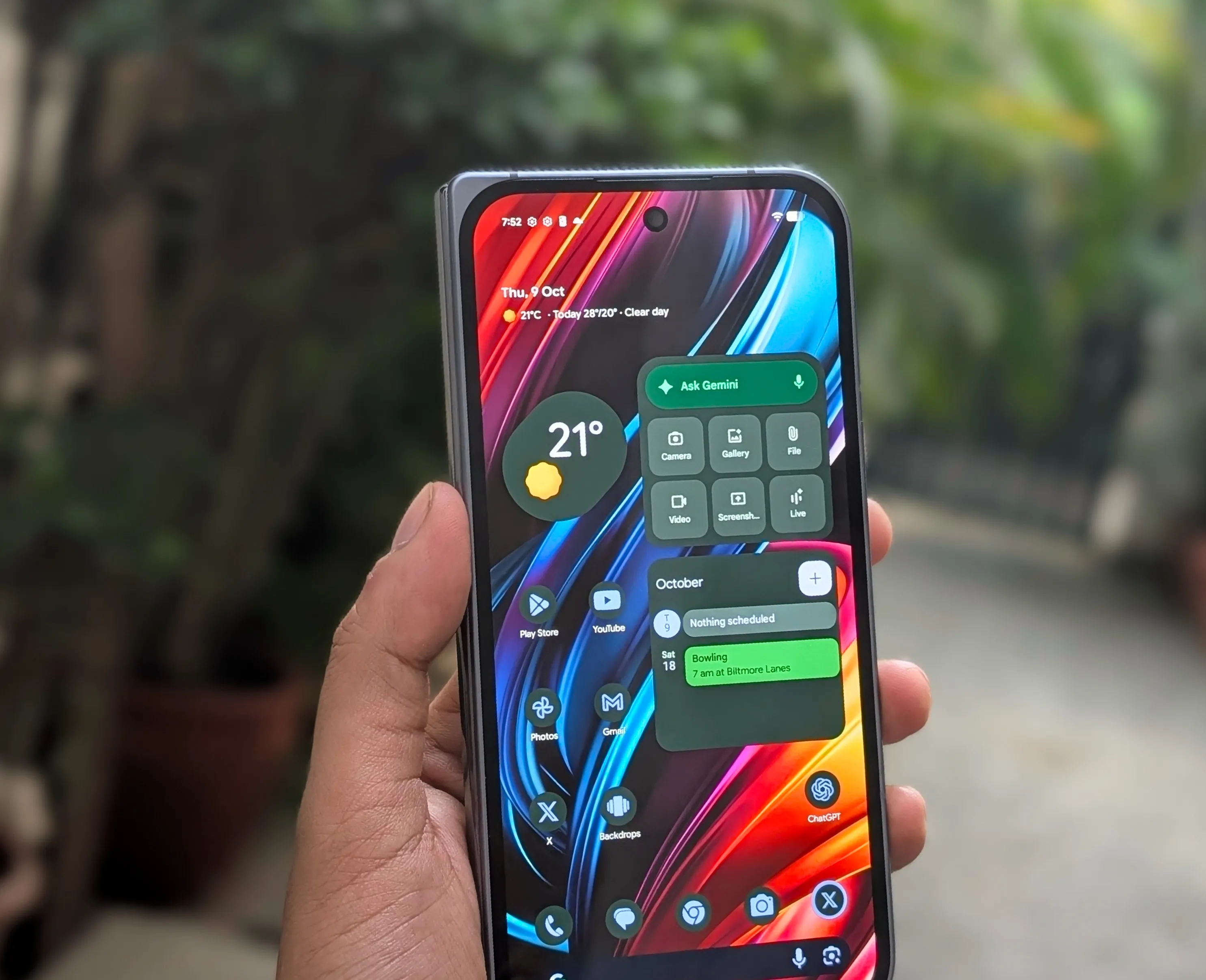
This is the first foldable I’ve used that doesn’t throw a wobbly in Delhi’s angry noon sun. Both the 6.4-inch outer Actua OLED and the 8-inch inner Flex OLED hit up to 3,000 nits peak. The outer panel’s “candy-bar” proportions make it behave like a normal phone, not a remote control. The inner panel is a proper tablet canvas—web pages breathe, Lightroom sliders feel precise, and split-screen multitasking actually suits human hands. Adaptive refresh up to 120 Hz on both displays keeps scrolling silk-smooth. Auto-brightness is conservative out of the box; nudge it up and the phone remembers your preference. Colour tuning leans “Pixel natural”—less neon than Samsung, more honest than many Chinese flagships. Watching HDR is a treat, although the crease catches reflections in bright café lighting. If you are the sort who doomscrolls in bed with one eye open, the inner screen’s minimum brightness is gentle enough to avoid accidental self-lobotomy.
Hinge & Usability: No Drama, Just Confidence
The hinge feels over-engineered in a good way. After a week of constant open-close cycles, split-angle table-top use, and the occasional one-handed “book flick,” there’s no play, no micro-rattles, and no chorus line of dust sneaking in. The IP68 rating is the headline, but it’s the day-to-day confidence that matters more. I’ve finally stopped checking the weather before taking a foldable out. Progress.
Tech Specs & India Price
Category
| Details
| India Price
| Rs 1,72,999 (16 GB RAM / 256 GB storage)
| Colours
| Moonstone (India)
| Dimensions & Weight
| ~155 mm tall; folded: ~10-plus mm thick; 258 g
| Displays
| Outer: 6.4-inch Actua OLED, up to 120 Hz, up to 3,000 nits (peak). Inner: 8-inch Flex OLED (UTG), 1–120 Hz, up to 3,000 nits (peak)
| Chipset
| Google Tensor G5 + Titan M2 security
| Memory/Storage
| 16 GB LPDDR5X / 256 GB UFS 4.0 (India variant)
| Cameras
| Rear: 48 MP wide + 10.5 MP ultrawide + 10.8 MP 5× telephoto (OIS); Front: 10 MP (outer) + 10 MP (inner)
| Video
| Up to 4K60, HDR; full stabilisation suite
| Battery & Charging
| ~5,000 mAh class battery; up to 30 W wired USB-C PPS (charger sold separately); up to 15 W Qi2 wireless (Pixelsnap magnets)
| Connectivity
| 5G, Wi-Fi 7, Bluetooth, UWB, NFC, USB-C 3.2; Dual-SIM (nano + eSIM)
| Durability
| IP68 water/dust resistance; gearless hinge; Corning Gorilla Glass Victus 2
|
Software & Big-Screen Experience: Pixel Zen Meets Real Productivity
Google’s big-screen Android is finally coherent. The persistent taskbar, app pairing, drag-and-drop across panes, and per-app continuity between outer and inner displays work with rare predictability. Animations are fluid. There are fewer “why did you do that?” moments than on rival foldables. My everyday workflow—WhatsApp on one side, Chrome or Gmail on the other, with Photos hovering for a quick drag—feels fluid, fast, and more desktop-like than any Pixel before it. Gemini’s on-device powers slot in neatly rather than screaming for attention. Summarising long articles offline is magical on the metro. Magic Compose for messages can be handy in controlled doses; Circle to Search remains an “of course” feature that’s impossible to give up; and the new “Magnet-friendly” Qi2 Pixelsnap bits (more on that next) make charging and accessory juggling delightfully low-friction. Are there bugs? Occasionally, a widget throws a tantrum after a rotation, and the taskbar sometimes forgets its manners after a heavy session with three apps. But the overall vibe is “polished Pixel,” not “science experiment.”
Qi2 & Pixelsnap: The MagSafe Moment For Pixel
Qi2 magnets transform a foldable’s bedside and desk life. Snap it onto a stand for calls. Snap it onto a battery pack when you’re late for a flight. Snap it onto a ring for a more secure selfie grip. Wireless charging at up to 15 W isn’t chart-topping, but the sheer ease is. Pair this with USB-C PPS wired charging (charger sold separately, as always) and you get a phone that plays well with modern charging ecosystems. Finally.
Performance: The Elephant In The Room Is Wearing A Tensor T-Shirt
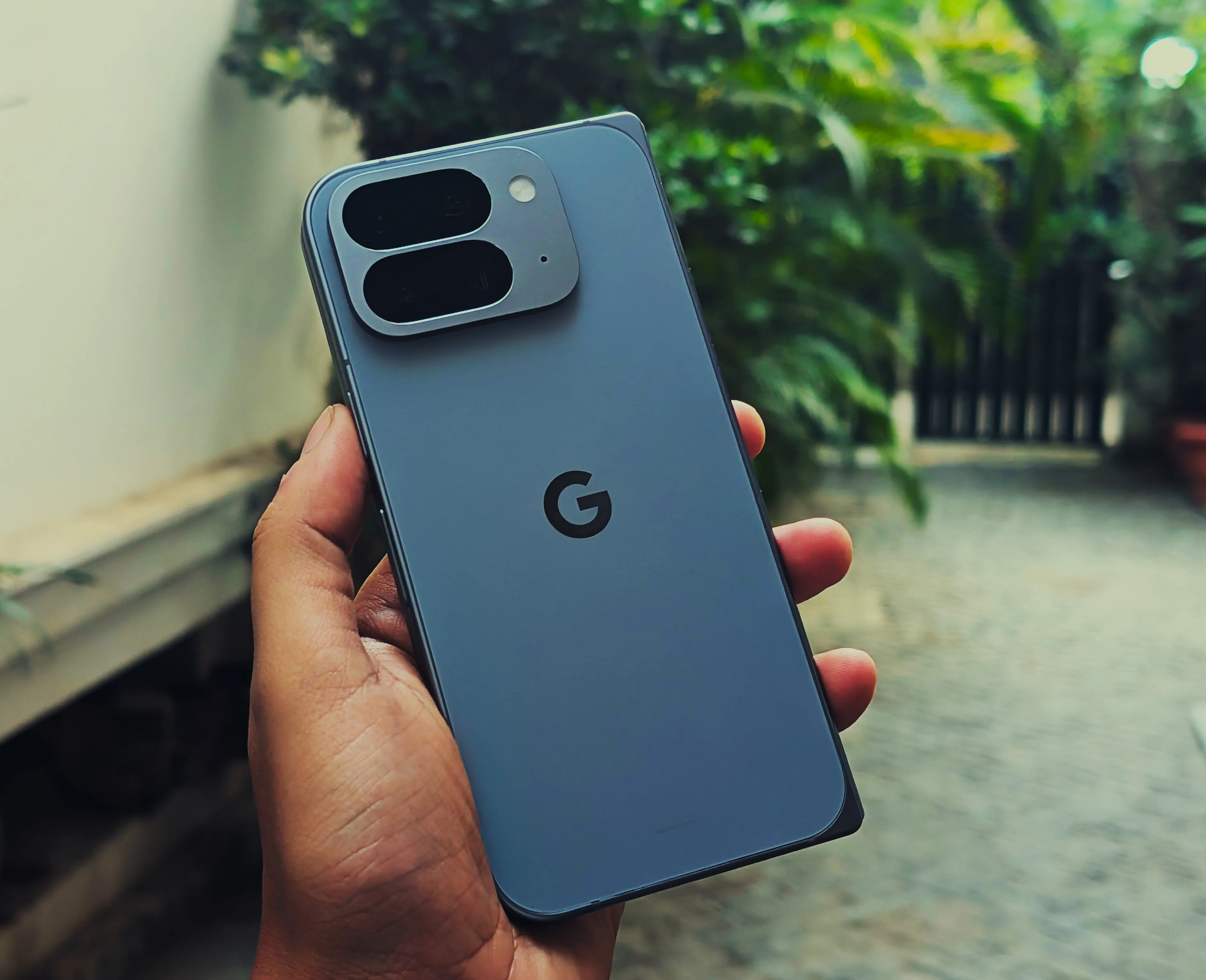
Let’s address the heat-seeking missile pointed at the Pixel’s heart. Tensor G5 is tuned for AI workflows and camera pipelines, not benchmark glory. Day to day, the phone feels fast: opening apps, juggling two panes, hopping between Lightroom and Gmail—no drama. The friction arrives when you push it. Video editing in VN or CapCut with multiple layers and colour LUTs exposes frame drops and export times that make Snapdragon 8 Elite devices feel like they’re running on nitrous. Heavy games play fine at medium-high settings but sometimes stutter during long sessions, and the chassis warms faster than Snapdragon and Dimensity rivals. Is it a deal-breaker? For most people, no. For creators who live in mobile timelines, yes. If your weeks are littered with travel, shoots, and quick edits for Reels, you will feel the gap. The fact that Google quietly keeps some mainstream benchmarks off the Store on this device doesn’t help with optics. It’s the Star Trek problem: the warp core is brilliant at tricky manoeuvres but lacks raw dilithium-burning grunt.
Battery Life: The Unexpected Triumph
I wasn’t expecting this. The Pixel 10 Pro Fold comfortably outlasted the Galaxy Z Fold 7 in my use. A typical day in Delhi—calls, messages, Chrome, camera bursts, Gemini queries, two hours of YouTube Music, an episode on Prime Video, and some Lightroom—ended with 20–25 percent in the tank. Long days of 6–7 hours of screen-on time were normal. Standby drain is low, and the device doesn’t nervously sip power with the inner screen shut. Wired top-ups are brisk enough for the “coffee to cab” charge; wireless is slower but convenient with magnets. This battery, on this bright a pair of screens, in this form factor, is the quiet win.
Cameras: Pixel Character, Foldable Context
Stills first: this is a very “Pixel” camera in look and feel. Contrast-forward shots with punchy micro-contrast and dependable white balance are the norm. Low-light stills are genuinely good for a foldable—clean, with that signature Google balance between noise suppression and detail. Portrait mode is surprisingly useful for product shots; edge detection is stable, and skin tones avoid the plasticky sheen you often get elsewhere. The 5× telephoto is usable, and the hybrid 10× is social-media good. Now the blunt part: if stills are a solid “B+,” video is a “C” facing an intervention. Stabilisation is fine, colour is mostly accurate, but detail and rolling-shutter control aren’t in the same league as Samsung and, especially, Apple. At the Prydz show, the Pixel grabbed some striking stills from the stands; the videos, next to iPhone 17 Pro Max footage, looked like they were wearing noise as sequins. Zoom video is where the gap yawns. Vivo and Samsung’s algorithms maintain detail and cadence better at equivalent focal lengths.
Audio, Calls & Connectivity: Dependable Where It Counts
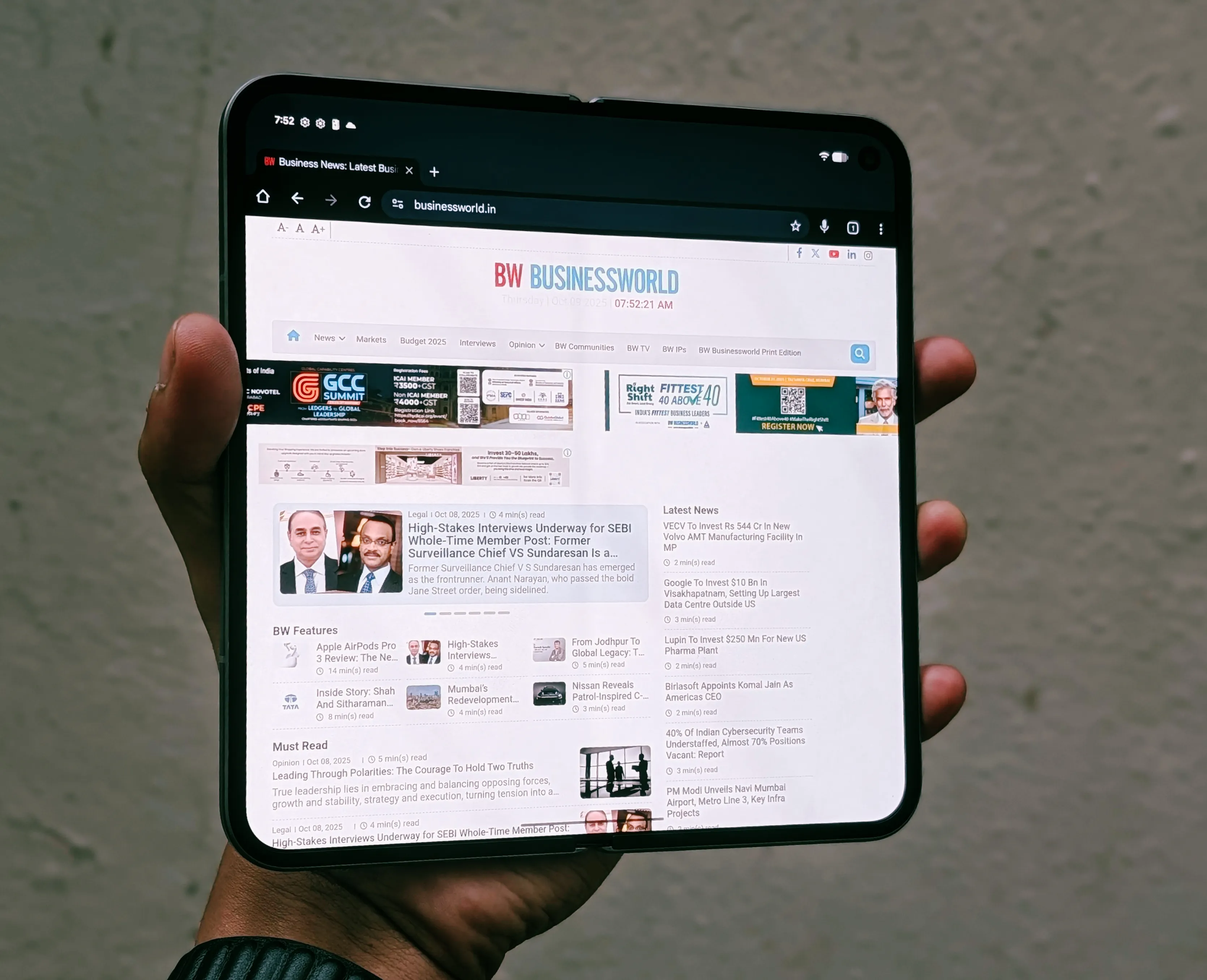
On Jio in Delhi-NCR, call quality was uneventful—in the best way. Dual-SIM (nano + eSIM) flexibility is handy, Wi-Fi performance is excellent on modern routers, and Bluetooth behaved impeccably with AirPods Pro 3, Sony WH-1000XM5, and a selection of TWS that pass through my desk weekly. The speakers are loud and reasonably full, though not in the iPhone 17 Pro Max’s class. Haptics are crisp, not buzzy; the keyboard feels surgical.
Security & Updates: The Long Game
Seven years of OS, security, and Pixel Drop updates. Titan M2 for secure elements. It’s the best software support promise in Android land, period. Buy this today and you’re covered till the early 2030s—a sentence that sounds like sci-fi until you count how old your last “kept as a backup” phone is. For enterprises and creators who don’t want to migrate gigabytes of projects every 24 months, that promise matters.
Day Five Reality Check: How It Actually Fit My Week
My week with the Pixel 10 Pro Fold was aggressively normal. Metro rides, Ubers, cafés with dodgy Wi-Fi, late-night edits, and the occasional sprint to catch an appointment. WhatsApp, ChatGPT, Lightroom, VidCap, VN Editor, Call of Duty Mobile, YouTube/YouTube Music, Netflix, Prime Video, Gmail—the usual suspects. The phone never made me adapt my habits to its quirks. It let me do more with the inner screen and didn’t punish me with anxiety every time water appeared. It’s the first foldable that felt like a daily driver rather than a long-term review unit.
Where It Trails: The Honest Bits
Let’s count the elephants. One: bulk. This phone is heavy and chunky. Two: bezels—still large for 2025 foldable standards, and the crease is visible when it catches a stray reflection. Three: performance; Tensor G5 is two steps behind when measured in seconds and frames rather than aspirational AI demos. Four: video—still not there; the others do it better and more consistently. Five: price; at Rs 1,72,999 for 256 GB, it’s expensive enough to demand fewer compromises.
AI & The Here-And-Now: Useful, Not Hypey
On-device Gemini is the sort of invisible feature you notice only when it fails. On the Pixel 10 Pro Fold, it mostly doesn’t. Summaries are quick and sensible. Transcription is snappy. Smart replies are on the right side of uncanny. The value of on-device processing isn’t just privacy; it’s reliability in flaky network conditions. Delhi’s patchy underground coverage was a non-issue for offline assist tasks. My sense is that as more third-party apps hook into the NPU, this will get better; right now, it’s already useful without shouting about itself.
Google’s new AI tricks feel less like a circus act and more like a competent stage manager. Magic Cue is the headline—quietly surfacing the right nugget (flight time, calendar clash, the app you were about to hunt for) so you stop ping-ponging between screens. It’s helpful rather than life-changing—think efficient PA, not HAL 9000. Ask Photos lets you boss edits around in plain English (“remove the reflections”), while Auto Best Take stitches one keeper from a chaos of group shots—Instagram-ready without ritual sacrifice. Gemini Live behaves like a chatty co-pilot for on-device tasks, particularly when the network sulks, and Voice Translate does eerily convincing cross-language calls—just shy of a Black Mirror moment. The theme across credible reviewers and YouTubers is consistent: there’s a lot of AI here that actually slots into daily workflows, with the odd gremlin and a few “nearly there” moments. In short, useful now, promising later—very Pixel.
Accessories & Ecosystem: The Convenience Dividend
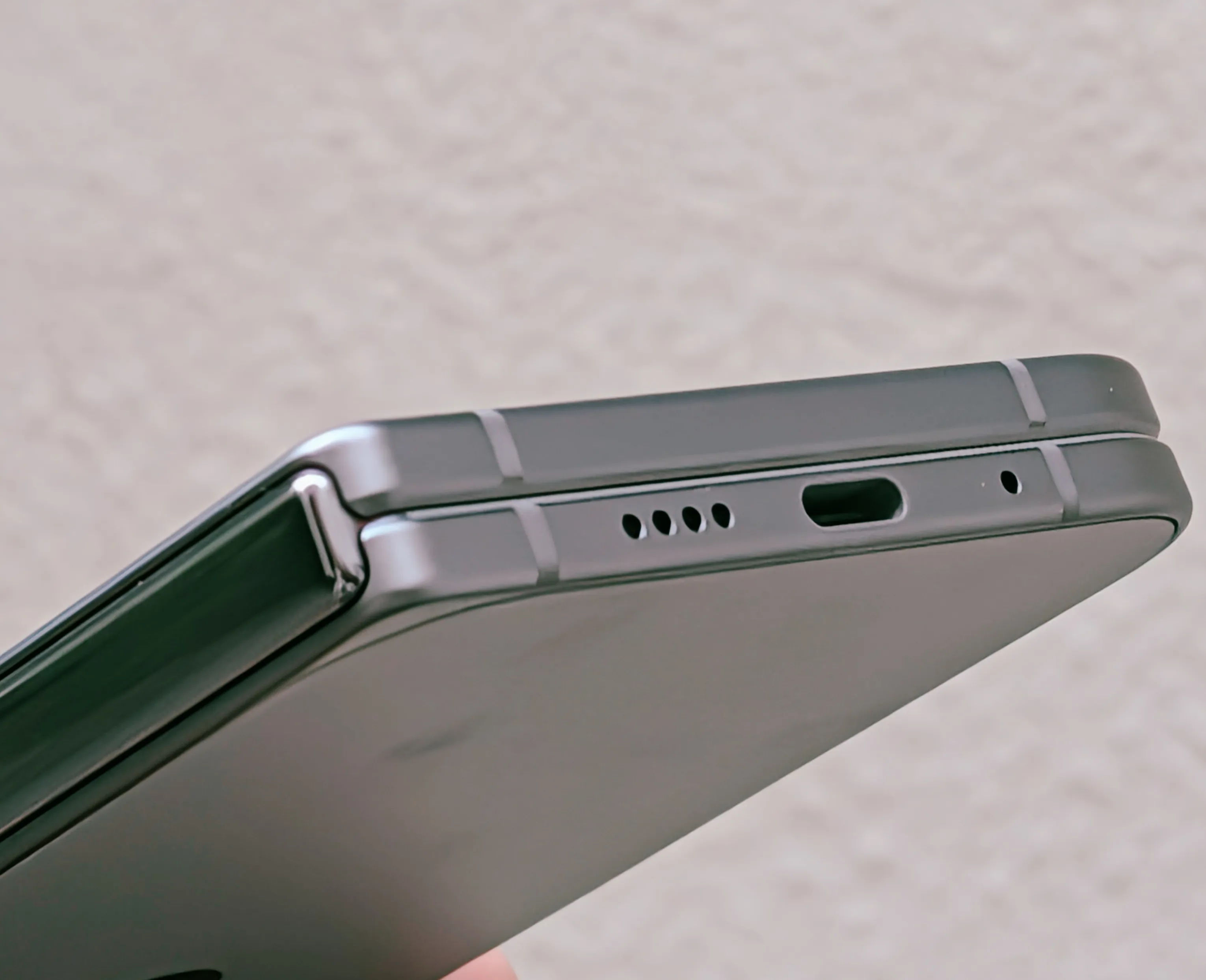
Magnets and a healthy accessory market are the difference between “I’ll plug in later” and “I’m topped up now.” Pixelsnap makes a tangible quality-of-life difference: stands, rings, wallets, and batteries that simply work. Case options are improving too. The foldable case problem—bulk + grip + hinge protection—remains, but at least you can assemble a setup that doesn’t feel like you’re carrying a paperback trapped in carbonite.
Competitors: Who Should Still Consider The Opposition?
If you want the thinnest possible book-style foldable with an absurdly tight hinge and minimum bezels, Samsung’s latest flagship foldable remains more elegant. If your life is zoom-heavy and video-first, Vivo and Samsung hold an edge. If your workload is “shoot – edit – export – upload” on the same device, Snapdragon 8 Elite hardware will keep your blood pressure lower. But if you value durability, bright and accurate screens, better-than-expected battery life, polished big-screen software, magnets, and long-term updates, the Pixel 10 Pro Fold earns its spot on your shortlist.
Value: What Are You Paying For?
You are paying for peace of mind (IP68), daylight-proof displays, a hinge that won’t age like a creaky door, magnets that make life easier, a clean big-screen Android experience, and a support window that flattens depreciation anxiety. You are also paying despite the weight, the bezels, the performance ceiling, and video that needs work. On balance, this is the most complete Pixel foldable yet—and the first one I’d confidently recommend to someone who’d actually buy a foldable rather than merely admire one in an airport lounge.
Verdict
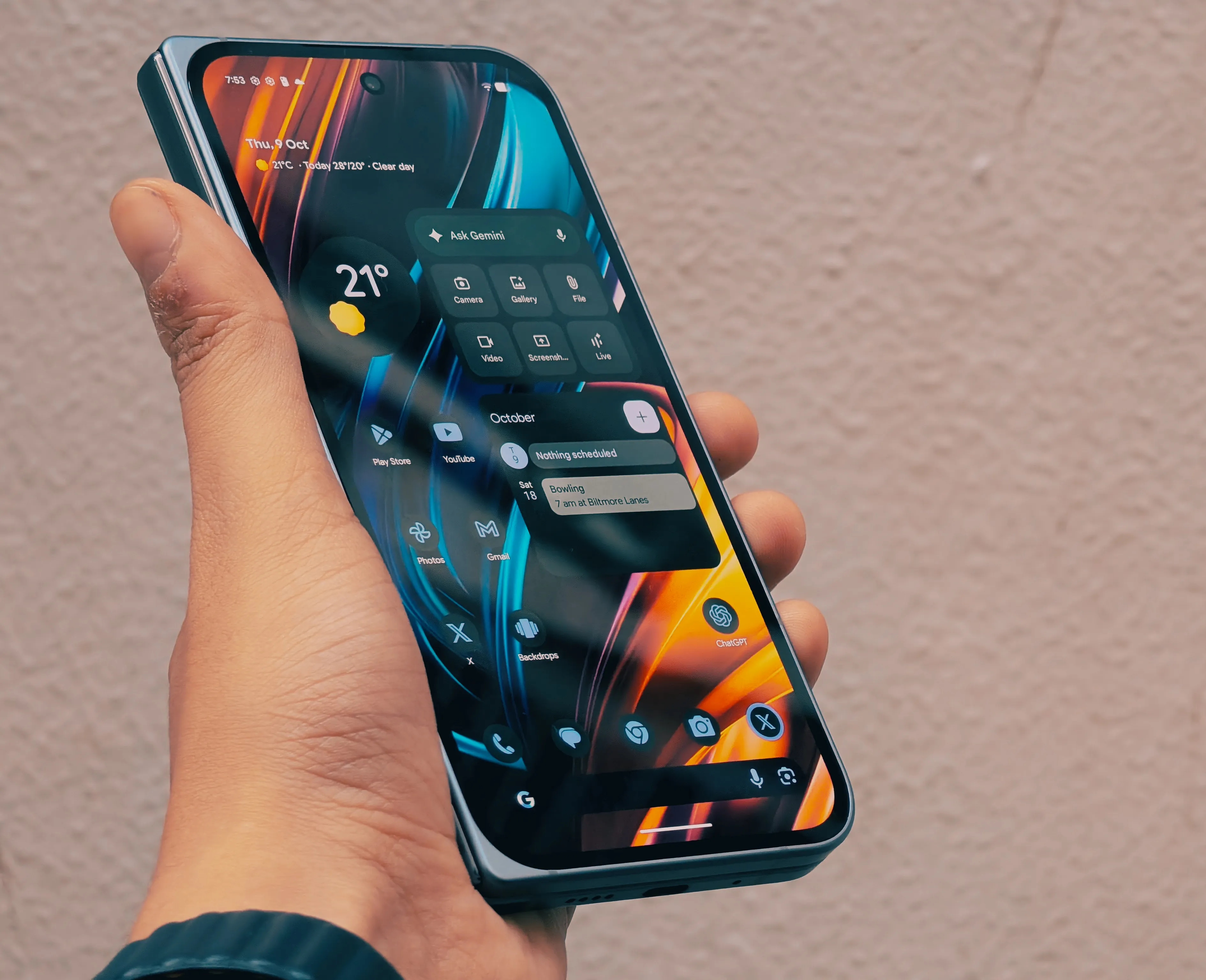
The Pixel 10 Pro Fold is the foldable that finally grew up, put on a raincoat, and learnt some manners. It won’t win every spec race, and it won’t dethrone Apple on video or Qualcomm on raw speed. But as a machine for modern life—messages, maps, media, multitasking—it is strangely, stubbornly delightful. It is not the best foldable at everything. It is the foldable I enjoyed using the most without worrying about it. And that, for a category that has lived on caveats, might be the biggest leap.
Rating
Category
| Score (10)
| Design & Build
| 8.5
| Displays
| 9.0
| Performance
| 6.0
| Cameras (Stills)
| 7.5
| Cameras (Video)
| 6.5
| Battery & Charging
| 8.5
| Software & AI
| 8.0
| Value
| 7.0
| Overall
| 7.5/10
|
|